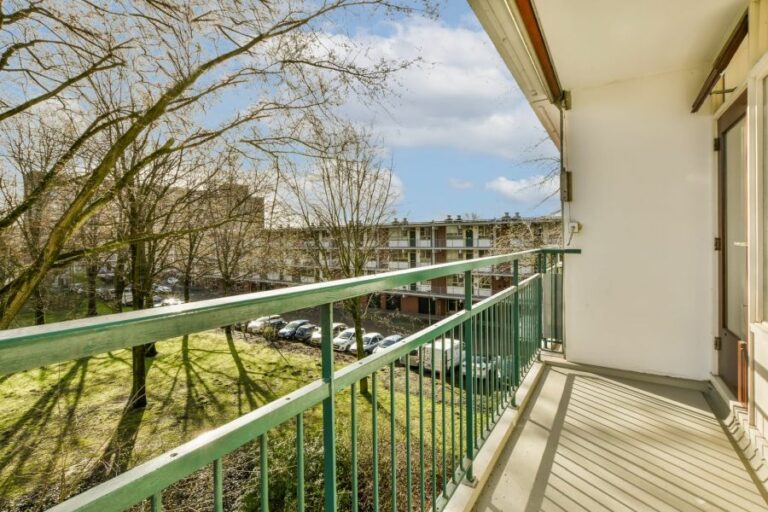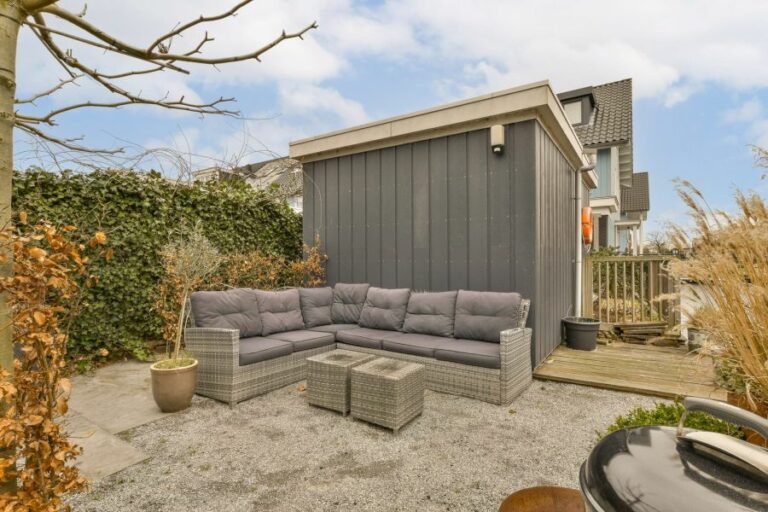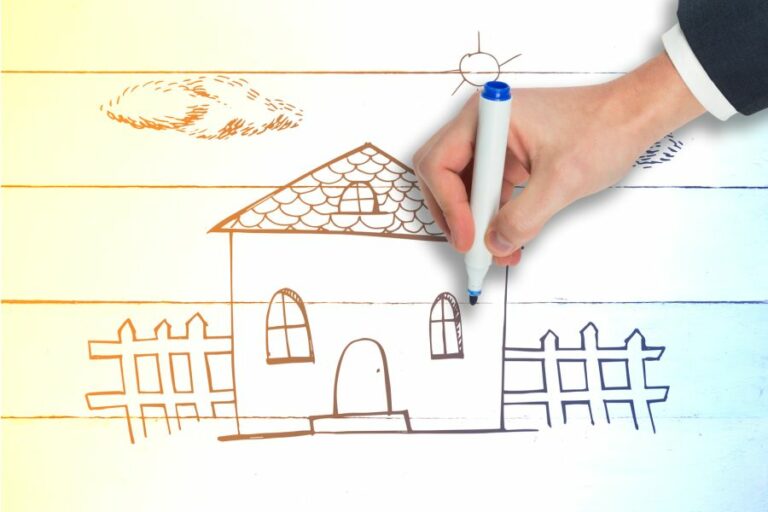How Long Should Outdoor Paint Dry Before Rain. What Pros Say
Are you planning a much-needed outdoor painting project but worried about unpredictable weather ruining your hard work? Rain can easily dampen the fresh look of your newly painted exteriors. But don’t fret! We’re here to guide you through the process of ensuring your paint dries effectively before an unexpected downpour. In this blog post, we’ll discuss the optimal drying time for various paint types and their compatibility with different weather conditions.
How long should outdoor paint dry before rain:
Outdoor paint drying time before rain depends on various factors, including paint type, humidity, temperature, and ventilation. Generally, water-based paints like latex and acrylic dry to the touch in 1-2 hours, while oil-based paints require 24-48 hours. Ensure the temperature is between 50-85F with humidity below 85%, and choose a day with a gentle breeze. To minimize rain interference, monitor the weather forecast, start painting early in the day, apply thin coats, and use rain-resistant paint formulations.

Discover the key factors affecting drying time, expert guidelines for ideal weather conditions, and practical tips to ensure your paintwork remains intact, even with the unpredictability of rain. Safeguard your fresh paint from washouts and damages with confidence.
Contents
- 1 What is the necessary duration for outdoor paint to dry prior to rainfall?
- 2 What is the duration required for exterior paint to cure fully?
- 3 What Are the Consequences if Rain Occurs Following Exterior Paint Application?
- 4 What is the duration required for paint to dry prior to rainfall?
- 5 What Actions to Take if Paint Gets Exposed to Rain?
What is the necessary duration for outdoor paint to dry prior to rainfall?
Every homeowner knows that painting the exterior of their house can be a daunting task. Timing is critical when it comes to applying a fresh coat of outdoor paint.
• The Pivotal Dance of Paint and Rain: Understanding Crucial Variables
The complex interplay of multiple variables makes it challenging to pinpoint a precise drying time for outdoor paint. Factors influencing drying times include paint type, humidity, temperature, and ventilation. Let’s examine each of these variables in detail.
– Paint Type: Exploring the Boundless Spectrum
Outdoor paints come in various types, such as oil-based, latex, and acrylic. Each has unique properties that affect its drying times.
Oil-Based Paints
Typically, oil-based paints take longer to dry than their water-based counterparts. With an oil-based paint, you can expect a curing period of 24 to 48 hours. However, these paints tend to be impervious to moisture, so they can withstand rain better once fully cured.
Latex and Acrylic Paints
Latex and acrylic paints are water-based, so they typically dry more quickly than oil-based paints. These paints can dry to the touch in just 1 to 2 hours. Their swift drying properties make them a popular choice for exterior painting projects.
– Humidity and Temperature: The Invisible Duettists
The delicate balance of humidity and temperature has a crucial impact on paint drying times. The ideal environment for outdoor painting typically falls within the range of 50 to 85 degrees Fahrenheit, with a humidity level below 85%.
Coping with Humidity
High humidity can prolong the paint’s drying time, as excessive moisture in the air hinders the paint’s ability to cure. If the humidity is above 85%, it’s best to postpone your painting project.
Adapting to Temperature
When temperatures dip below 50 degrees or soar above 85 degrees, the paint may not adhere to the surface correctly, leading to issues like cracking, blistering, or peeling. It’s essential to monitor the weather forecast vigilantly and plan your painting project accordingly.
– Ventilation: The Unseen Maestro
Airflow is critical when it comes to the drying process of paint. Choose a day with a gentle breeze to help speed up drying and prevent dust or debris from settling on the wet paint.
• The Winning Strategy: Measures for Paint Drying Before Rain
To ensure your outdoor paint project isn’t marred by unexpected rain, consider these practical steps:
- Accurate Forecast: Keep a close eye on weather forecasts, and look for a window of at least 72 hours without rain or high humidity.
- Early Start: Begin your painting project early in the day to maximize drying time before nightfall when temperatures drop, and humidity levels increase.
- Thin Coats: Apply thinner paint coats, which will dry much quicker than one thick coat.
- Rain Resistant Paint: Choose paint formulations designed to withstand rain after a shorter drying period. Some products promise resistance even after as little as 1 hour of drying time.
• Conclusion: How Long Before Rain?
Ultimately, the question of how long to let outdoor paint dry before rain is nuanced and multifaceted. Taking into account the paint type, humidity, temperature, and ventilation, a general rule of thumb is to leave at least 4 hours for water-based paint or 24 hours for oil-based paint to dry before rain.
It’s always wise to err on the side of caution and allow for additional time when possible. With careful planning, attention to detail, and adaptability, you can ensure the success of your outdoor painting project.
Type of Paint | Minimum Drying Time Before Rain |
|---|---|
Acrylic Latex Paint | 2-4 hours |
Oil-based Paint | 8-24 hours |
Exterior Stain | 24-48 hours |
Exterior Varnish | 24 hours |
What is the duration required for exterior paint to cure fully?
The art of painting has always been a cornerstone of human creativity, and in our modern era, this still holds true. Applying fresh coats of paint to the exterior walls of residential or commercial properties not only breathes new life into them but also bolsters their aesthetic appeal.
While the undertaking itself can be quite pleasurable, what isn’t admittedly as clear-cut is deciphering the precise duration necessary for the paint to fully cure. Allow this article to illuminate you on this very subject, covering the various factors and conditions that contribute to paint curing timelines.
• The Essence of Paint Curing: Demystifying Drying and Curing
While novice painters tend to conflate the terms “drying” and “curing,” they are in fact distinct processes. Recognizing these disparities can provide greater clarity on how the complete curing process unfolds.
Drying refers to the evaporation of the paint’s solvent or water, which makes the coating solidify and become touch-dry. On the other hand, curing is a more intricate process that necessitates the formation of molecular bonds within the paint’s constituents.
This bonding bolsters the paint’s resistance to external elements and enhances its durability.
• Paint Curing Timelines: A Multifaceted Approach
Curing timelines vary, contingent upon multiple factors. The following expanse highlights some of the most significant elements that determine these durations.
– Type of Exterior Paint
Two primary types of paints dominate the market: water-based and oil-based paints.
Water-Based Paints
Also known as latex or acrylic paints, these are distinguished by their emulsion in water. They have increasingly risen to prominence due to their reduced environmental impact and ease of application.
Curing times for water-based paints tend to be quicker, with touch-dry durations typically ranging between 1 to 2 hours. Complete curing, however, could extend up to 30 days.
Oil-Based Paints
Characterized by their solvent base, oil-based paints have long been a staple for exterior projects owing to their protracted resilience. Although superior in durability, they come with longer touch-dry periods, often lasting between 6 to 8 hours.
Complete curing of oil-based paints may necessitate upwards of 7 days or more.
– Ambient Weather Conditions
The external environment plays a pivotal role in shaping paint-curing timelines. Various meteorological factors impact the efficacy and speed of the curing process.
Temperature
Optimal paint application and curing occur within a specific temperature range, typically 50°F to 85°F (10°C to 30°C). Suboptimal temperatures can induce curing delays or even compromise the quality of the paint job.
Humidity
A higher humidity level prolongs the evaporation process of paint solvents, causing extended curing timelines. Dry weather expedites evaporation, reducing the time required for drying and curing.
Sunlight
Direct sunlight can facilitate quicker drying times, but excessive heat and UV radiation may lead to peeling or bubbling. Hence, it is crucial to strike a balance between natural light and shade when painting exterior surfaces.
– Surface Material and Preparation
The substrate of the surface can impact paint curing durations. Different materials inherently have distinct properties, which consequently affect the paint’s adherence, absorption, and curing process. Some common surface materials include:
- Wooden surfaces: Despite being porous, they can take longer to cure as they may require additional layers of primer, paint, or stain.
- Concrete and masonry: This may necessitate ample curing time for the applied paint to penetrate the surface fully.
- Vinyl siding: This can have faster curing times, given that the paint adheres uniformly to the non-porous material.
Surface preparation also influences curing timelines. A surface primed properly, cleaned, and free of dust, grime, and mildew allows for better paint adhesion and expedites the curing process.
• In Conclusion: Mindful Painting Ensures Optimal Results
The often-queried notion of “how long does it take for exterior paint to cure” can indeed unveil a compendious array of answers. However, bearing in mind the aforementioned factors, along with patience and attentiveness, will guarantee triumphant outcomes in any paint endeavor.
Paint Type | Dry to Touch | Recoat Time | Fully Cured |
|---|---|---|---|
Latex-based | 1-2 hours | 4 hours | 30 days |
Oil-based | 6-8 hours | 24 hours | 7-14 days |
Acrylic | 1-4 hours | 4-6 hours | 30 days |
Urethane | 1-4 hours | 6-12 hours | 30 days |
What Are the Consequences if Rain Occurs Following Exterior Paint Application?
• Consequences of Meteorological Menace
Nature’s mercurial mood can prove detrimental to exterior works. When unanticipated showers impinge upon freshly-painted surfaces, a slew of complications intrude. Understanding the repercussions is pivotal for efficacious planning and execution of exterior painting endeavors.
– Jeopardizing Adhesion: A Peril of Precipitation
Rainy conditions are inauspicious for recently-applied coatings. A core concern is the disruption of optimal adhesion. Water infiltration introduces unwanted moisture, creating unsavory conditions for paint cohesion. Consequently, proper adherence to the surface is circumvented, culminating in a sub-par, short-lived result.
– Blistering: The Bane of Rain and Paint
As the formidable tandem of moisture and paint coalesce, they conjure an adverse phenomenon known as blistering. This nefarious process engenders the formation of minuscule bubbles or pockets within the paint film.
Blisters mar the otherwise flawless facade, instigating unsightly defects and causing dissatisfaction to homeowners and contractors alike.
– Discoloration: An Unpalatable Outcome
Rain, coupled with improper drying, can lead to the dreaded demon of discoloration. A disarmed facade beset with unsynchronized hues emerges, a direct consequence of uneven water exposure. To avert this calamity, thorough vigilance against meteorological maleficence is an absolute imperative.
• Efficacious Strategies to Mitigate Rain-induced Ruination
Mitigation of rain-related complications hinges on meticulous planning and assiduous execution. When engaging in exterior painting, adopt measures to circumvent climate-induced catastrophes.
– Harnessing Meteorological Prognostication
An indispensable ally in the battle against weather adversity is the strategic employment of forecasts. Bolstered by technology’s vanguard, meteorological prediction is readily accessible, facilitating informed decision-making. Choose opportune periods for painting that offer the necessary respite from rain.
– Maximizing Ambient Temperature for Optimal Drying
Fostering fast drying is essential for withstanding unpredictable precipitation. Higher ambient temperatures facilitate expedited evaporation, accelerating the curing process. Endeavor to commence exterior painting projects when thermic conditions are propitious.
– Impervious Barriers: The Paint Protector
Introducing formidable barriers against impending precipitation fortifies the drying process. Tarps, protective sheets, or covers provide a surefire solution against intrusive water.
Implementing these stalwart guardians ensures the paint’s performance remains untarnished by weather-induced malevolence.
• Overcoming the Crisis: Remedial Measures for Rain-stricken Paintjobs
When a soggy catastrophe afflicts an erstwhile flawless exterior painting venture, fret not. Alleviation is within reach.
– Eliminating Moisture: A Fundamental Imperative
The nemesis of waterlogged paint, moisture expulsion, should be swiftly carried out. Deploy sponges, towels, or any other feasible means to eradicate residual dampness. The quickest purgation of unwelcome wetness provides recourse to near-normalcy.
– Repaint, Rejuvenate: A Resilient Rebound
With moisture judiciously expelled, it is time to initiate the repaint process. Assiduously apply a touch-up to the surface, assuring the satisfactory reclamation of the compromised facade. Thus, a triumphant resolution emerges despite nature’s capricious temperament.
In conclusion, the perils of rainfall upon freshly-applied exterior paint can usher in a multitude of complications, imperiling adhesion, spawning blistering, and catalyzing discoloration.
Thoughtful planning, in tandem with judicious timing, proved to be invaluable for combatting the precarious whims of weather. Furthermore, engaging efficacious interventions for rain-stricken paint jobs guarantees a resilient and triumphant finale.
Event | Outcome |
|---|---|
Light rain after the paint has dried partially | Minor impact, some spots may require touch-ups |
Heavy rain after the paint has dried partially | Significant impact, repainting might be necessary on affected areas |
Light rain after the paint has dried completely | No impact, the paint should remain intact |
Heavy rain after the paint has dried completely | Minimal impact, some wear and tear may start to show over time |
Rain during the paint application process | Major impact, the paint may not adhere properly and may require complete cleanup and restart |
What is the duration required for paint to dry prior to rainfall?
Your domicile exterior requires a fresh coat of perceptive pigmentation, yet Mother Nature threatens with her vexing torrents. Fear not, for herein lies an abstruse disquisition dedicated to the delicate art of paint drying amidst fickle weather forecasts.
• Enter the Pigment: The Science of Paint
To truly comprehend the art of paint drying prior to impending downpours, one must delve into the essence of paint itself. Composed of intricate components, paint involves a magnificent juxtaposition of binder, pigment, and solvent that enables it to adhere to surfaces and provide a vibrant luster.
– Binder: Architect of Adhesion
The binder constitutes the paint’s adhesive element, uniting the other constituents and binding them to the painting surface. Formed from synthetic or natural resinous materials, like acrylic, vinyl, polyurethane, or alkyd, this constituent ensures seamless adhesion and conjures a robust layer resistant to wear.
– Pigment: Sculptor of Color
A meandering miscellany of mineral or organic substances encompasses the pigments that impart the vibrant chromatic hues to paint. These finely ground particles consist of assorted colors and opacities, shaping the paint’s ultimate aesthetic allure.
– Solvent: Facilitator of Fluidity
The solvent imparts paint its fluidity, simplifying the application process. In obeisance to the laws of evaporation, the solvent dissipates, permitting the delectable union of binder and pigment to the surface.
In water-based paints, water serves as the solvent, while oil-based varieties employ organic solutions.
• The Paradox of Paint Drying: Variables at Play
The journey of paint from its nascent wet state to one of hardened resplendence proves to be a kaleidoscopic ballet of factors. Weather conditions, paint type, and thickness each exert their influence on the drying timeline.
– The Mercurial Ballet of Weather Conditions: Temperature and Relative Humidity
Temperature and humidity emerge as critical co-conspirators in the paint drying process. Ideal conditions for drying involve moderate temperatures with limited fluctuations and relative humidity levels lower than 70%.
Swift temperature transmutations and heightened humidity thwart the drying process, compelling the paint to submit to prolonged dampness.
– A Taxonomy of Paint: Water-Based versus Oil-Based
The dichotomy between water and oil-based paints teases out disparities in drying duration. Water-based paints, such as acrylic and latex, beseech the mercy of evaporation for their solvent to disperse, necessitating a brief dry-to-touch period of 1 to 2 hours.
Contrastingly, oil-based paints demand 6 to 8 hours due to their slower oxidation process.
– Quandaries of Application: Paint Thickness Remonstration
The thickness of the paint layer wields a formidable influence over drying time. A profligacy of paint prolongs the arduous path towards dryness, as the solvent entwined within the paint’s profound folds refuses to surrender to the interlaced laws of evaporation and oxidation.
• Answering the Call of Rain: A Timetable for Paint Drying
A well-spent sojourn through the meticulous layers of paint science equips us with insights to recite a suggested timetable for drying amidst impending rainfall. For water-based paints, a respite of 4 to 6 hours prior to the onset of showers proves prudent.
Meanwhile, oil-based paints necessitate a hearty 24 hours of evaporation and oxidation to stave off the impending deluge.
An eloquent understanding of the marriage between paint’s enigmatic constitution and the dynamic determinants of the environment imparts valuable knowledge, enabling one to decipher the complexities of paint drying.
As you embark upon your own ventures in the realm of pigmentation and meteorology, remember the wise words of Vincent Van Gogh: “Great things are not done by impulse but by a series of small things brought together.”
Type of Paint | Average Drying Time |
|---|---|
Water-based paint | 1-2 hours |
Oil-based paint | 6-8 hours |
Latex paint | 2-4 hours |
Enamel paint | 8-24 hours |
Acrylic paint | 20 minutes – 1 hour |
What Actions to Take if Paint Gets Exposed to Rain?
Painting a home or outdoor structure requires meticulous planning, keen observation, and scrupulous execution. However, unexpected weather events can wreak havoc on freshly-painted surfaces, dampening the enthusiasm of eager DIYers and seasoned professionals alike.
To maintain your newly-coated exteriors in tip-top condition, heed these timely guidelines when dealing with rain-drenched paint jobs.
• Table of Contents
- Initial Indications: Detecting the Deluge’s Aftermath
- Immediate Interventions: Salvaging Sodden Surfaces
- Proactive Preparations: Averting Future Hailstorms’ Havoc
– Initial Indications: Detecting the Deluge’s Aftermath
When faced with rain-soaked paint, the first crucial step involves discerning the damage caused. Vigilantly survey the afflicted area, bearing the following hallmarks of rain-damaged paint in mind:
- Blistering: Bubbles forming under the paint film, a nefarious byproduct of moisture intrusion
- Dilution: Diluted paint appears watery and anemic, robbed of its chromatic vigor and viscosity
- Sagging: Paint drooping downward, succumbing to gravity and slipping from its intended fixture
- Unevenness: Surface disparities, wherein certain sections suffer greater dilapidation than their undisturbed counterparts
– Immediate Interventions: Salvaging Sodden Surfaces
After appraising the ruination inflicted by rainfall, employ these expeditious solutions to salvage your dampened paint job:
- Dry It Out: Assiduously undertake moisture elimination, utilizing absorbent materials and ample ventilation. A judicious combination of desiccants and high-powered fans aids in expediting the desiccation process.
- Remove Debris: Eradicate detritus befouling the painted surface, particularly ensconced dirt and foliage that exacerbate unseemly discoloration; a gentle cleansing with a non-abrasive sponge suffices for this task.
- Scrape Away: Extricate the damaged paint using a putty knife or similar tool; exercise caution to avoid exacerbating the issue by gouging pristine sections inadvertently.
- Fill and Sand: Employ a high-quality spackling compound to fill holes and imperfections; subsequently, sand the surface to achieve a uniformly smooth finish, preparing it for repainting.
- Prime the Area: Utilize a premium exterior primer that specifically caters to damp conditions, ensuring the substrate is prepped for a fresh coat of paint.
- Repaint: Instate a new layer of paint, selecting a robust and weather-resistant product that withstands the rigors of precipitation.
– Proactive Preparations: Averting Future Hailstorms’ Havoc
Prevention trumps cure when it comes to managing the impact of meteorological conditions on paint jobs. Keep these preparatory measures in mind for future painting endeavors:
- Consistently Consult Forecasts: Stay attuned to local weather projections, staving off potential disruptions by selecting a painting date with a minimal likelihood of rain.
- Swiftly Secure: In case of unexpected showers, expeditiously cover the freshly-painted area with waterproof tarps or plastic sheeting, shielding it from the adverse effects of precipitation.
- Humidity Awareness: Account for humidity levels, as elevated moisture content can impede paint adherence and drying time, heightening susceptibility to rain-related complications.
- Opt for Weather-Resilient Paint: Ascertain the paint product’s meteorological compatibility certain formulations are tailored to provide enhanced resistance against weather-induced duress.
Embarking on exterior painting projects calls for judicious preparation, astute adaptability, and a keen awareness of weather-induced challenges.
By implementing the aforementioned practices, you can transform rain-pummeled paint jobs into resilient masterpieces unfazed by the caprices of inclement weather.







